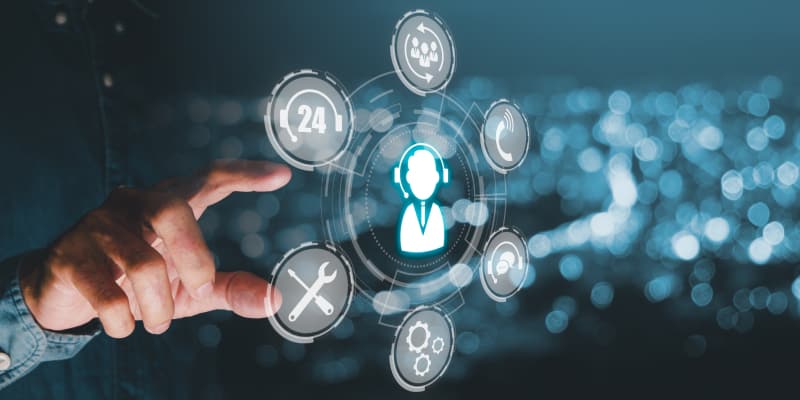
In the digital age, your company’s communication lines are vital. With cyber threats ever present, it is critical to protect these channels. Sound strategies and tools help defend your sensitive data integrity and confidentiality.
This guide helps you understand why you need to safeguard your communication with essential tactics under guidance from reliable unified communication services in Roanoke.
Understanding Communication Security Fundamentals
Digital interaction is now the global norm, making Communication Security (COMSEC) vital. COMSEC defends data shared via chat, phone, or email from unwanted eyes and access. It is a key part of cybersecurity that keeps sensitive information safe and private.
COMSEC has several main parts that add to your system’s overall safety:
- Physical security protects the actual devices and structures used in communication.
- Emission security stops others from picking up your signals.
- Encryption security scrambles your messages so outsiders can’t read them.
- Transmission security ensures safe data travel without interception or changes.
Grasping these parts is just the start. Proper actions are crucial for maintaining communication integrity and confidentiality, which is crucial for trust and smooth operations.
The Critical Role of Communication Security
Today, securing your communication is a must. It keeps personal, financial, and strategic information safe. COMSEC is the shield for your organization’s communications. The practices keep your data unchanged and private, stopping unauthorized changes and access. Using strong COMSEC secures data and upholds client and partner trust, which is key for lasting success.
COMSECs core ideas that guide data safety are:
- Confidentiality keeps your data from unwanted access.
- Integrity ensures your info stays the same during transit.
- Availability ensures authorized users can get information when needed.
Think about COMSEC beyond digital safety. Without managing who can physically access your servers and data hubs, other security steps might fail.
Implementing Physical Security Measures
Do not forget physical security while working on your firm’s communication safety. Network staff must keep communication gear and areas secure to stop changes or theft. This means only letting certain people into server rooms, using entry control systems, and setting up cameras to watch and deter unapproved access.
Checking hardware helps avoid security risks. Having your gear on site can help, giving direct oversight and less risk of breaches. Though crucial, physical security is just one part of the puzzle. A safe communication space also needs a secure network design, which works well with these physical steps.
Designing a Secure Network Architecture
Building your firm’s network safety starts with embedding security into the system design. This helps smooth data flow and cuts the chance of unwanted access. It is vital to have a network built of independent units. These units keep your communication systems running, even if one part has trouble. A constant power source is vital to avoid outages that could cause data loss or security issues. For high-safety situations, networks cut off from less secure ones offer extra safety.
Your network plan should have detailed diagrams showing how data moves. This helps spot potential weak spots. Firewalls control network traffic and keep user services separate from system management for extra safety.
Stay watchful as you build your network. Your steps will create a strong barrier against unwanted access, keeping your sensitive information safe.
Strategies to Prevent Unauthorized Access
To defend your communication systems from unwanted access, you should use several key strategies:
- Multi-factor authentication (MFA) asks users for several identity proofs, considerably boosting security.
- Access controls decide who can access what data and how much, in accordance with data integrity laws.
- It is critical to quickly stop access for employees who leave to stop them from using old rights.
- Services that handle unauthenticated user requests are important. They check and filter how users interact with your systems.
As you enhance your access control, remember that protecting data also means wrapping it in security that outsiders can’t easily remove.
Implementing Data Encryption Strategies
Making your firm’s communication security stronger means making data encryption a priority. Robust encryption methods like SSL/TLS and AES are key. They scramble your data to keep it from unwanted eyes as it travels. End-to-end encryption ensures your data stays safe from start to finish, with no chance of being picked up.
Keeping cryptographic keys safe is key. These keys lock and unlock your data and must be handled carefully to avoid misuse. Plans for their creation, sharing, storage, and retirement are needed to keep your encryption solid.
Encrypting stored data also keeps it unreadable to anyone without permission. Keeping cryptographic methods and key storage up to date is needed to stay ahead of new threats.
With these encryption methods in place, your data receives the needed protection layer for trust and smooth operations. As you deal with these complex issues, setting up strong admin controls is the next step. This ensures that only approved eyes see the right information.
Administration Controls for Effective Access Management
Administration controls are key to managing staff access and keeping your firm’s communications safe. Giving access based on job roles ensures staff only have the permissions they need, lowering the risk of unwanted access to sensitive data. Regular security checks are an important tool, helping find and fix weak spots before they are used.
Keeping systems up to date with new software patches is key to maintaining strong and current security. Handling login info is just as important. This means creating strong passwords, changing them often, and ensuring past employees cannot get in.
Regular checks on employee access and admin controls are needed to stop data leaks. This ongoing watch lets you quickly react to any odd activity and adjust controls to keep a secure space. These steps create a solid framework to protect your communications when used regularly.
Conducting Regular Security Audits for COMSEC
For COMSEC checks, it is wise to hire outside experts. They bring a fresh view to the check-up, guarding against inside threats. Besides planned checks, surprise audits work well when there is odd activity or many login tries. These audits can stop harmful insider actions since staff know their moves can be checked anytime.
Regular and surprise audits are key to maintaining strong communication security and ensuring your defenses stay tough against inside and outside dangers. As your firm continues to focus on safety, consider how internal training can complement these efforts, keeping your team aware and ready.
Internal Training to Enhance Communication Security
In today’s connected world, regular training is needed to teach staff about safe communication, which can cut the chance of cyberattacks. This training must change as cybersecurity threats do.
Training for remote workers is especially important. They might not have the same security at home as at the office. Staff should know the special challenges of remote work, like keeping devices safe and the risks of using personal gear for work.
With a well-taught team, you can more confidently use tools for secure business talks, knowing your staff understands their importance and how to use them right. With your team ready to handle communication security complexity, it is time to look at the tech tools that help with these efforts.
Selecting Tools for Secure Business Communication
When choosing business communication tools, ensure they keep your firm’s sensitive information safe. AI tools are leading the way in finding and handling threats. Email services with end-to-end encryption, like Mailfence, add extra safety with digital signatures and multi-factor authentication.
It is also key for these tools to work on many platforms and respect user privacy by not collecting extra data. This careful tool choice is a key step in keeping your business talks safe and keeping your data confidential and of integrity.
Proactive Strategies for Communication Security
Today, keeping your communications secure is a must. As you work to protect sensitive info, it is important to take a proactive approach. Let us look at some strategies to strengthen your firm’s communication security.
Secure Authentication and Limited Access
Using strong password rules and multi-factor authentication (MFA) reduces the chance of unwanted access. Following the least privilege rule is also crucial, giving access only for needed job tasks. By limiting needless access, you are lowering the possible ways for attackers to get in, keeping your communications safe from interception or misuse.
Employing Strong End to End Encryption
Another important strategy is using strong end-to-end encryption. This keeps intercepted communications unreadable to anyone without the right decryption key.
The Benefits of Ephemeral Messaging
Consider using ephemeral messaging, where messages are deleted after a set time. This greatly reduces the chance of sensitive information being leaked.
Avoiding Metadata Collection
Be careful of metadata collection. Some secure communication tools may not store message content but still collect metadata, which can reveal a great deal about your firm’s communication patterns.
With these strategies in place, your firm can keep the confidentiality and integrity of its communications, protecting sensitive info in a changing digital world.
Empowering Communication Security Next Steps with CMIT Solutions
Boosting your firm’s communication security is a constant process needing commitment and strategic steps. As you add advanced security, strong encryption, and careful admin controls, your communication setup becomes a stronghold of digital safety. Being the leading IT solutions provider in Roanoke, CMIT Solutions has the expertise that matches your need for secure operations.
We understand that each business has its own needs, which is why we offer IT support as varied as the dangers you face. Contact us now for a full IT review and start on a path to unmatched communication security.
Our IT Services
CMIT Solutions of Roanoke delivers reliable, proactive, and secure IT services and expert technology consulting. We are proud to serve businesses in Roanoke, Christiansburg, Blacksburg, Radford, and Wytheville, ensuring your technology powerfully supports your success throughout the region. Let our local experts handle your IT needs.
| Managed IT Services | Cybersecurity | Productivity Applications |
| IT Support | Cloud Services | Network Management |
| Compliance | Data Backup | Unified Communications |
| IT Guidance | IT Procurement |

